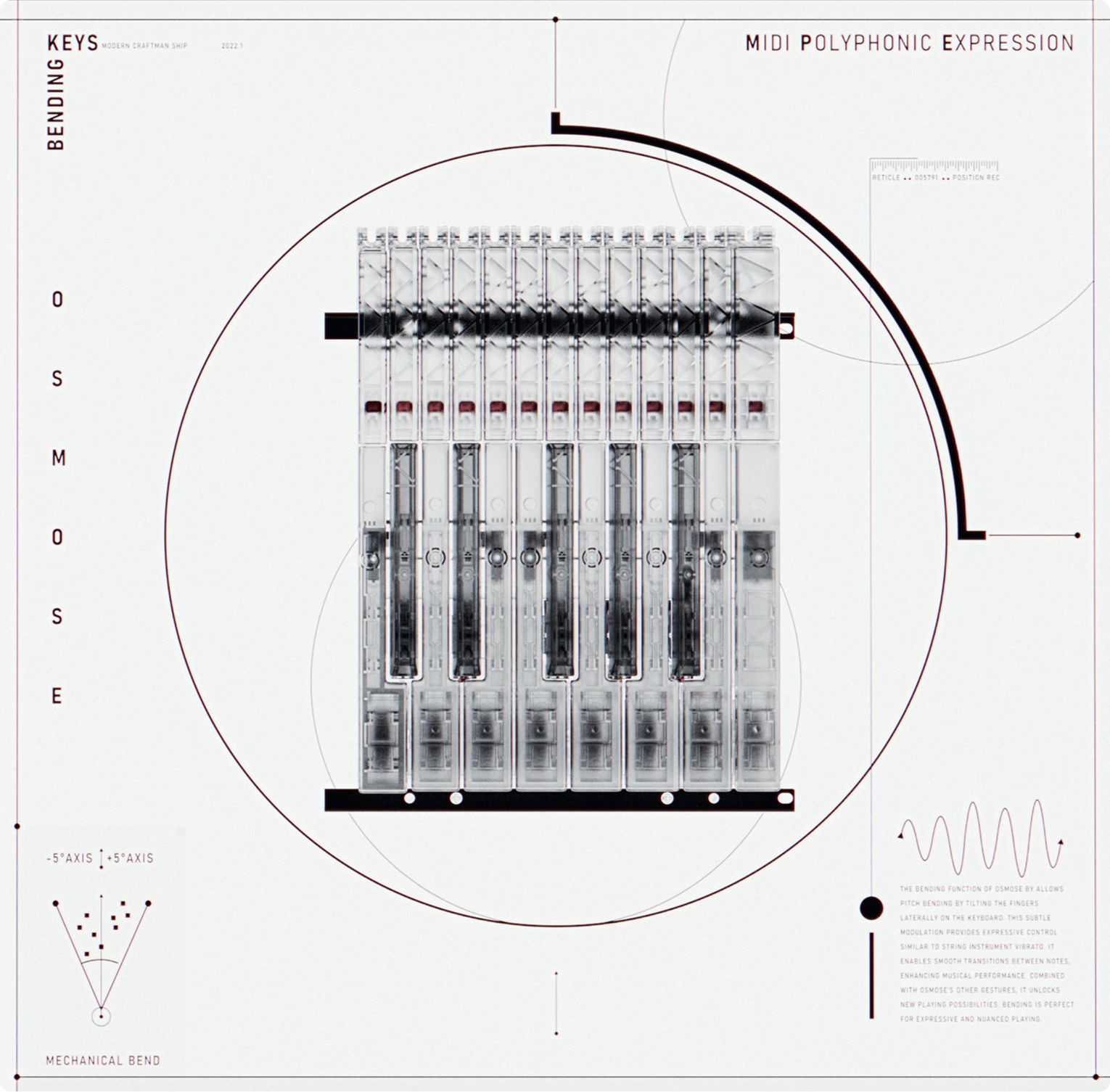want to know
What
is MPE?

discover
mpe
mpe on/off
 play video
play video
mpe vs traditional midi
mpe Per-Note Control
Each note played can have a different pressure, timbre, and pitch bend value. Each note is granted its own MIDI channel, allowing much more expression for the player.
midi Global Control
All notes of a sound share a single channel and the same control data. Pitch and timbre changes apply to all notes without differences; only the note velocity is individual.
mpe Augmented dynamics
Your fingers can modulate each note’s intensity and timbre separately and continuously with intuitive gestures.
midi Limited dynamics
For individual notes, MIDI velocity offers a one-time starting dynamic value. Dynamic changes are usually applied globally, and gestures are not registered.
mpe Ultimate precision
Notes are registered as soon as you brush the keys, and your gestures keep on shaping the sound continuously. Internally in Osmose, some per-note expression is transmitted with superior 14-bit resolution as opposed to the usual 7-bit resolution.
midi Standard precision
You need to hit a certain threshold for triggering notes in the first place, and softer notes might not be registered. Only 128 steps of velocity intensity are registered (7-bit resolution). Continuous gestures are not registered.
mpe Growing Support
MPE is rapidly being adopted by software and hardware manufacturers, forming a bridge to MIDI 2.0, which will integrate high-resolution per-note expression natively into the protocol.
midi Universal Support
MIDI has been the standard for digital music communication since the 1980s. It is universally supported by almost any hardware and software on the market.

mpe at expressive e
At Expressive E, MPE is at the core of our vision.
Inspired by early electronic music pioneers & expressivity geniuses, we proudly consider ourselves MPE experts and enthusiasts, dedicated to making musical expressivity intuitive and inspiring for musicians.
We prioritize a seamless connection between gesture and sound, without compromising feel. That’s why we design instruments like Osmose and Touché, built on real mechanical principles, like modern craftsmanship, offering haptic feedback and high resolution for the most expressive experience.
Developed with and for musicians, these instruments undergo hundreds of hours of refinement to achieve the perfect feel. And because expression is all about sound, we create a tailored sonic ecosystem that fully unlocks their potential ensuring a natural, immersive connection between sound and gesture.
about expressive ewatch mpe in action
Check our expressive and MPE tutorials to become an expert on the topic. Express yourself more easily in any music genre.
mpe in your daw
Excited to get started with MPE in your favorite DAW? More and more DAWs offer native MPE support (see the list further below), but the implementation varies. Our tutorial video series sheds light on those different workflows and shall help you integrate Osmose into your MPE music production setup.
mpe compatible daws
| DAW | mpe native support | setup tutorial |
|---|---|---|
| Ableton Live | yes, since 11.0 | link |
| Bitwig Studio | yes, since 2.1 | link |
| Apple Logic Pro | yes, since 10.5 | link |
| Steinberg Cubase/Nuendo | yes, since 11.0 | link |
| PreSonus Studio One | yes, since 5.2 | link |
| Tracktion Waveform | yes, since 11.0 | coming soon |
| MOTU Digital Performer | Yes, since 11.0 | coming soon |
| Cockos Reaper | Limited | link |
| Avid ProTools | no | - |
| Imagine-Line FL Studio | no | - |
| Propellerhead Reason | no | - |
| BandLab Cakewalk | no | - |
mpe compatible tools
See which instruments, DAWs, plugins & controllers support MPE. Our thanks go out to Frank Lý from KVR Audio forums, who compiled the original listing.

 ableton live
ableton live




